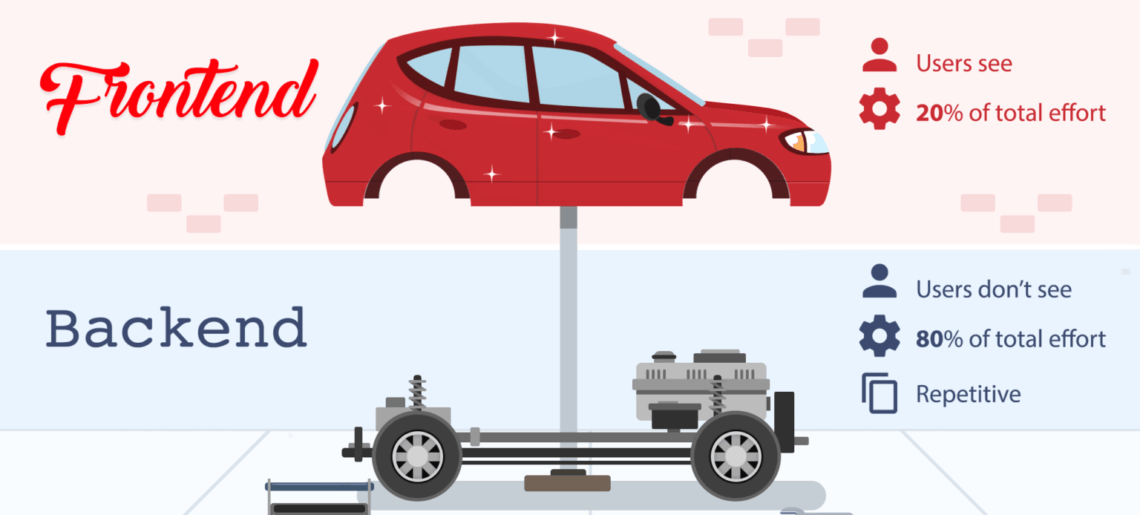Backend meaning and everything you need to know about it

Whenever a computer program is developed, whether it is a website, a computer application, or a mobile application, there are two main parts.
One is the part that the users can see and interact with. It is the frontend of the program.
The other part that the users cannot see or interact with and holds all the functionalities is called the backend of the program.
We can also distinguish them as a data access layer for the backend while the frontend’s presentation layer.
So, the backend covers the following aspects of a program.
- The hardware resources
- The software technology
- The network infrastructure
All these technologies work together to provide functionality to the program. The users interact with the program using the frontend or the interface in any computer program. While the developers work on the backend functionalities just like a mechanic works on a car engine.
Contents
The difference between Server-Side and Client-Side
When we talk about the backend of a computer program, there are two different types.
Client-Side
The client-side of a computer program refers to the functionalities and activities occurring on the end user’s device, including the user experience and user interface. It could be any computer device that supports that program.
Example
The backend meaning in software is a piece of an application that the user does not access directly. An elementary example is of using the website.
While you are accessing the website, you are on the client-side of the program. It is because you are accessing the interface of the system. However, your system will refer to the server for the functionalities and data access features.
Server-Side
The server-side refers to the functions running on the server like data accessing, database management, notifications, authentication, server application functions, and all other functions. We can say that all the features that are accessed by the client-side, they are running here.
The Backend Architecture Overview
When we talk about the backend of any computer program, its type depends on the type of the project and its requirements.
These requirements are studied, and then the backend architecture is selected to be appropriate for the program and fulfill all the requirements.
There are three main classes of server architecture. The three classes or server architecture are:
- Serverless Backend
- Server-oriented Backend
- Decentralized Backend
Here are the details about each of them.
Serverless Backend
Serverless backend is one of the most popular server architectures these days. The server management and maintenance are under some third-party service providers. These providers are also responsible for the backup and security of the system.
As the service provider manages the server, there is no need for server management in the program. It makes it a magnificent architecture for the developers. The speed of development is the main reason here.
This architecture also provides hassle-free development and deployment because all developers have to deal with the application’s frontend. According to the experts, this is a more secure option because the service providers have developers working day and night to secure their systems.
However, being a cloud-based technology, the chances of attacks are also high. So, it is a great option to take protective measures. Examples for serverless architectures are a Backend as a Service and Function as a Service.
Examples of serverless backends are Back4app, Firebase, and Kinvey.
Server-Oriented Backend
It is the type of architecture where special server computers are implemented to serve as the system’s server and provide the hosting services. It is also one of the most popular architectures.
The best part about using this architecture is using a physical or cloud-based server according to your requirements. Some other benefits are listed below.
- Data sharing
- Integrations
- Single access point
Examples of server-oriented backends are AWS, Azure, Digital Ocean, etc.
Decentralized Backend
In this type of server architecture, nobody takes the responsibility of backend management. Different physical servers are located in other physical locations, and there is no central location of the main server.
The networks made on this type of architecture are usually open-source, and they provide peer-to-peer networking. The best part about using this architecture is that developers can use any language to develop the frontend. However, the front-end hosting is needed to be done by other apps like IPFS or Swarm.
This architecture is applied in many practical applications. Some of them are Bitcoin and Ethereum. To know more about Bitcoin, please check this Bitcoin calculator.
Conclusion
Here we discussed the backend definition and differences between backend and frontend.
All the backends and the client and server sides of the backend. Backend is a necessary part of every program to operate. It provides a program similar to that of an engine to a car.
In a web development example (i.e., website, web pages), while the frontend is used for int user interactions, the backend is used for managing all the functionalities like data transfer.
An excellent backend infrastructure definition is the part of a program because that is responsible for any system’s proper functioning and that the user cannot see or interact.
Even the frontend depends on the backend for most of its functions. However, the best is when the frontend and the backend work together to provide a good interface and functionality.
FAQ
What the meaning of a backend?
Backend is the part of a software that the users cannot see or interact with and holds all the functionalities.
What is a frontend?
Frontend is the part that the users can see and interact with.
What are the backend categories?
– Serverless
– Server-Based
– Decentralized



